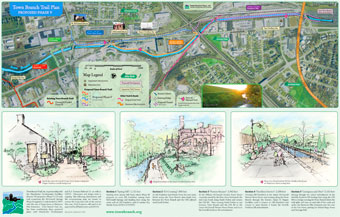(LFUCG TIF Task Force) SEES PLANS
Distillery District needs $81 million
DEVELOPER CITES ECONOMIC IMPACT OF VENUE
By Beverly Fortune
Lexington Herald-Leader
bfortune@herald-leader.com
Sept. 11, 2008
The proposed $190 million project along a 28-acre industrial corridor would include a small bourbon distillery and museum, 277 condominiums, 83,000 square feet of office space, 700 parking spaces, 118,000 square feet of retail space and restaurants and a 125-room boutique hotel. It would be developed in three phases, to be completed in 2012.
Between new construction and adapting old structures, the district would revitalize downtown’s west end, said developer Barry McNees.
McNees told the city’s tax-increment financing task force that to succeed, the Lexington Distillery District must have $81 million in TIF money from local and state government.
Copies of an analysis by C.H. Johnson Consulting on the financial feasibility of the project were given to task force members.
“My goal today is to talk about the fundamental impact this project will have on this community, which will be transformative to the west end of downtown,” McNees said.
“This will be a destination for local citizens. It will be a tourism magnet that will bring new tax dollars to Kentucky and Lexington,” he said. “The economic impact can be huge.”
McNees said he and his dozen partners have already invested $9 million buying and renovating several industrial buildings. “TIF is the missing piece,” he said.
The Old Tarr warehouse that once housed 8,000 barrels of bourbon sat empty for years before McNees began converting it into an events venue that can hold 2,000 people. They also own the abandoned James E. Pepper Distillery down the street.
About $27 million of the $81 million in TIF funds would go to rehabilitate old buildings. Portions of these structures will incorporate public facilities such as museums, theaters, art galleries, a children’s development center and a non-profit commercial incubator.
Now the area generates $122,000 annually in state and local taxes, or $3.6 million over the next 20 years, McNees said. Once redevelopment begins, taxes would bring in $148 million over the same period. More than 3,500 jobs would be created, including 2,600 construction jobs, according to the feasibility analysis.
The city’s TIF consultant, Jim Parsons, said he liked the Distillery District’s chances of being accepted as a TIF project by the state. “On paper, it’s a good project. It clearly meets the definition of a blighted area,” Parsons said.
The state has not yet approved any smaller, mixed-used TIF projects like the Distillery District. In 2007, five TIF projects costing more than $200 million got state approval. Parsons said the state wanted to get a smaller mixed-use project approved to demonstrate to other cities how it works.
Getting the city’s seal of approval with a TIF application will give the project credibility and help line up financial investors, McNees said.
Tom Blues, whose council district includes Manchester Street, said he was impressed with the project’s creativity and how it will revitalize surrounding areas, such as nearby Irishtown. “A great deal of planning and imagination has gone into this,” Blues said.
Blues also appreciated McNees’ straightforward approach. “In two meetings we’ve had with Barry, he’s answered tough questions honestly and in great detail,” he said. “There’s been no stonewalling, no secretiveness, no evasive answers.”
For council member Andrea James, the Distillery District “is really what a TIF should be, a blighted area that really needs a TIF to succeed.”
“I’m impressed that the tax increment could be what they’re stating it,” she said. “This looks like it is an ideal project for TIF.”
Commissioner of law Logan Askew was asked to prepare a resolution defining the Distillery District’s TIF boundaries, the 16 qualifying public infrastructure projects and their expected costs and have it ready for the task force’s next meeting on Wednesday.
Reach Beverly Fortune at (859) 231-3251 or 1-800-950-6397, Ext. 3251.
This story was published by the Herald-Leader and can be found at www.kentucky.com

